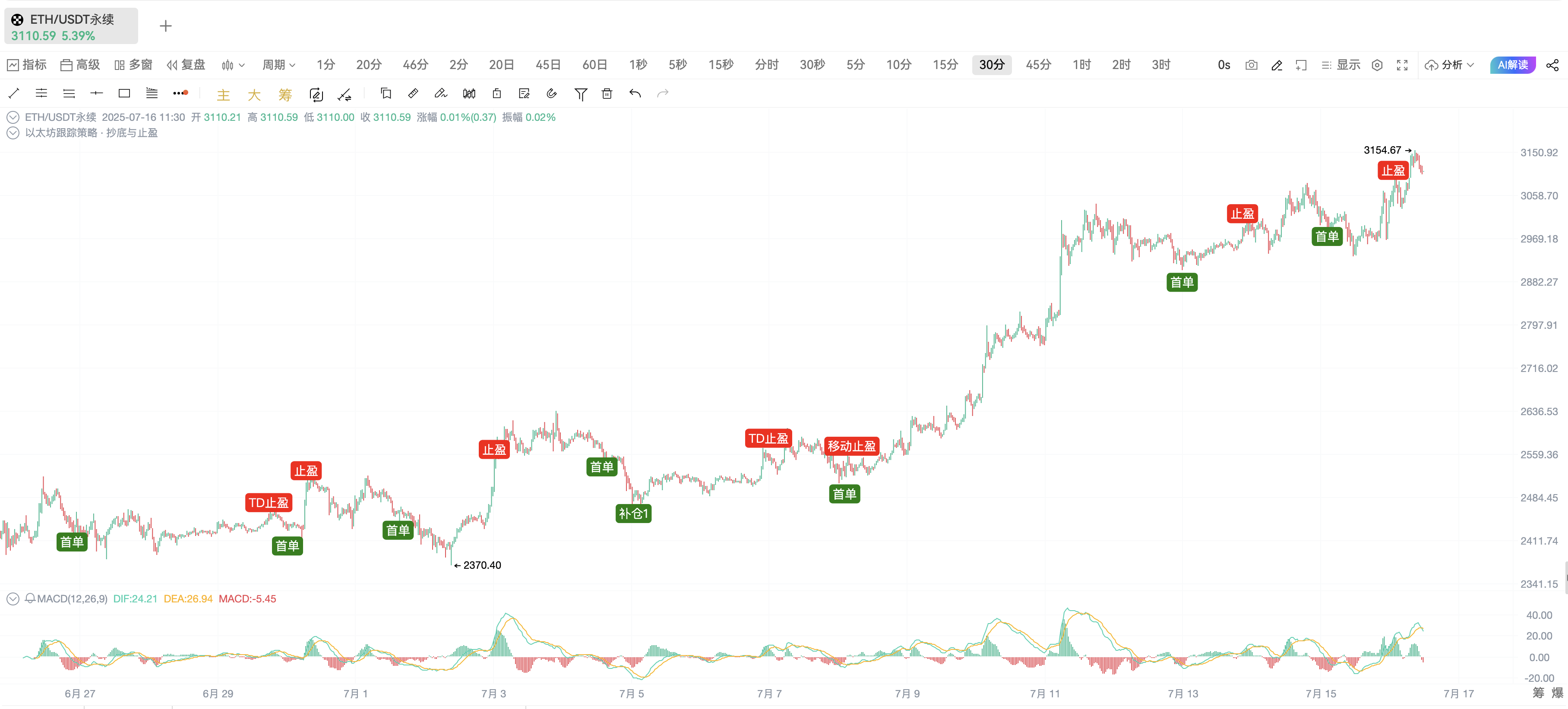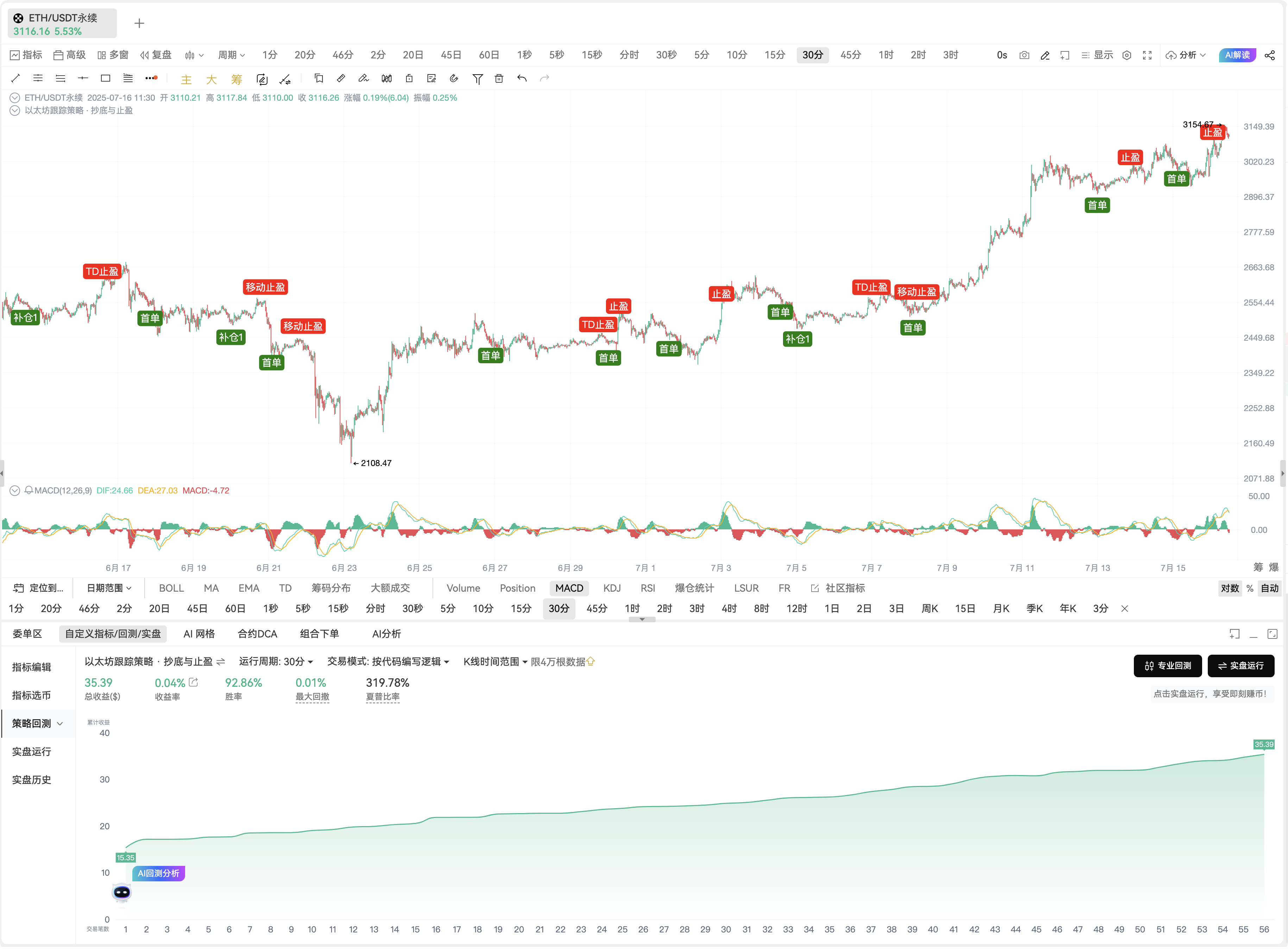Facing the high-frequency fluctuations and sentiment-driven price trends in the cryptocurrency market, relying solely on "feelings" is no longer viable. AiCoin has launched the Ethereum Tracking Strategy, driven by quantitative signals to guide operational logic, combining TD reversals, intelligent averaging down, and a dynamic profit-taking system to help you navigate through the emotional fog and lock in every trend and rebound.
This article will systematically analyze the core principles, practical effects, and execution recommendations of this strategy, equipping you with a "steady win" trading plan truly suitable for volatile markets and trend transitions.
I. Core Principles of the Ethereum Tracking Strategy
1. Strategy Logic
1.1 Capturing Market Rhythm: The Art of Trends and Reversals
The price fluctuations of Ethereum are not random; they unfold with market cycles, driven by macro factors and on-chain hotspots. Within the ups and downs of price volatility, important investment nodes such as "prolonged trends" and "key reversals" always emerge. The core of the tracking strategy is to scientifically analyze and capture these golden moments, helping investors position themselves or take profits, thus gaining an advantageous position amidst volatility.
1.2 Relying on Custom Indicators: Simplifying Complexity, Locking in the Best Opportunities
In the face of changing market conditions, the core indicators designed through customization provide users with clear and precise buy and sell recommendations by combining price trends, volatility intensity, and reversal signals. This design frees you from the traditional dilemma of "operating based on feelings," allowing your profit-taking and bottom-fishing actions to be data-driven, significantly enhancing the success rate.
1.3 Clear Objectives: Steady Wins, Earning Stable Money Without Taking Risks
The key to investing is not blindly pursuing high returns but gradually amplifying profit opportunities through a rigorously validated profit-taking and bottom-fishing strategy while reducing the costs of ineffective operations. This strategy helps investors efficiently accumulate profits through automated execution or clear operational guidance.
2. Strategy Core
2.1 Capturing Trend Directions, Embracing Reversal Opportunities
The tracking strategy employs a dual approach: on one hand, it clarifies price direction through trend indicators; on the other hand, it combines reversal signal indicators to accurately judge opportunities for price pullbacks or rebounds, allowing for buying or stop-loss actions in high-probability areas. This design is both robust and highly flexible.
2.2 Risk Management: Maximizing Profit Potential While Safeguarding Principal
No excellent strategy is complete without good risk awareness. This strategy combines position control and stop-loss mechanisms to ensure that investors capture more profits during bullish trends while quickly stopping losses during sharp price fluctuations, firmly protecting the principal from losses.
3. Specific Principles
3.1 Precisely Capturing Local Reversals, Quickly Positioning for Rebound Opportunities
Based on core signals such as the TD reversal indicator and key support levels, it monitors local rebound waves after rapid price declines in real-time. Once a relative bottom signal is confirmed, the strategy quickly positions the first round of trades while reserving subsequent funds to respond to potential multiple operations.
3.2 Strategic Averaging Down, Flexibly Diluting Investment Costs
If the price continues to decline after opening a position at a local reversal, it will accurately average down in batches based on the decline ratio, further flattening the overall holding cost. This way, when the market is about to bottom out, it occupies a price advantage, holding the maximum chips for the reversal, efficiently utilizing funds to cope with market fluctuations.
3.3 Scientific Profit-Taking and Exiting, Ensuring Profits Are Under Control
Abandoning human interference, the strategy centers around a custom profit-taking indicator, dynamically calculating to trigger target profit-taking points in a timely manner. When the market enters the reversal zone, it decisively exits based on signals from the TD reversal indicator, maximizing potential profits and avoiding greed and hesitation from subjective operations. Additionally, in the event of sudden declines, the strategy has a clear stop-loss mechanism built in, firmly controlling investment risks within acceptable limits.
II. Signal Effectiveness of the Ethereum Tracking Strategy

Figure 1: OKX-ETHUSDT Perpetual Contract 30-Minute Cycle
Signal Description:
First Order: First capture of the downward reversal signal to open a position
Averaging Down 1: Second order placed after the first order to dilute costs
TD Profit-Taking: Execute profit-taking upon the appearance of the TD reversal signal
Profit-Taking: Execute profit-taking after reaching the profit-taking target range
Trailing Stop: Profit reaches a certain target price, then retraces a certain percentage to exit profitably
III. Win Rate Analysis of the Ethereum Tracking Strategy

Figure 2: OKX-ETHUSDT Perpetual Contract 30-Minute Cycle Backtest
Backtest Highlights: Signal Win Rate as High as 92.86%
IV. Usage Recommendations for the Ethereum Tracking Strategy
1. When is it most suitable to use?
Answer: During volatile markets, during oscillating upward trends, and during pullbacks after rapid surges.
Reason 1: Frequent up and down fluctuations in the market allow for flexible operations using local reversal signals from the TD indicator, especially suitable for quickly positioning for rebounds and utilizing averaging down mechanisms to dilute costs and enhance profit potential.
Reason 2: When the market is clearly in an upward oscillation, the trend indicators of the tracking strategy can help you quickly judge the overall direction and accurately capture price reversal signals, making it suitable for efficiently following market trends while automatically taking profits at high points.
2. How to execute more efficiently?
Answer: It is recommended to use the strategy's 30-minute or 1-hour cycle signals.
Reason: This strategy is suitable for short-term traders to gain profits from oscillating and upward trends. Especially when price fluctuations are intense but the direction is likely upward (such as Ethereum's price continuously swinging significantly up and down). By capturing TD reversal signals and combining with averaging down mechanisms, it can effectively enhance profitability in volatile markets.
3. How to avoid risks?
Answer: Reasonably choose cycles and positions.
Reason: Do not blindly pursue high-frequency trading with short cycles; choosing too short a cycle may lead to low returns and high transaction fees. Additionally, avoid executing this strategy in clearly downward trending markets to prevent continuous averaging down and stop-loss situations.
V. Indicator Source Code
// @version=2
// If the initial order amount is 50u, then in extreme cases, a total of 400u will be needed after averaging down 3 times. Please prepare sufficient funds in advance.
[td]=td(close);
start_signal = td == -9
end_signal = td == 9
stop_loss = 0.2 // Stop-loss line; after all averaging down orders are placed, if the price continues to drop, it will trigger a forced stop-loss.
take_profit = 0.02 // Profit-taking line; if the price rises xx compared to the average opening price, it will take profit and close the position.
safety_order_pct = 0.02 // The interval for placing averaging down orders; after placing an averaging down order, if it drops xx, it will trigger another averaging down, with a maximum of 3 averaging down orders.
first_order_amount = 0.1 // The amount for the first order; subsequent averaging down orders will automatically calculate the order amount.
safety_order1_amount = first_order_amount
safety_order2_amount = first_order_amount + safety_order1_amount
safety_order3_amount = first_order_amount + safety_order1_amount + safety_order2_amount
safety_order4_amount = first_order_amount + safety_order1_amount + safety_order2_amount + safety_order3_amount
safety_order5_amount = first_order_amount + safety_order1_amount + safety_order2_amount + safety_order3_amount + safety_order4_amount
var long_count = 0
var long_avg = 0
var long_close = 0
var long_amount = 0
first_order = start_signal and long_count == 0
enterLongAmount(first_order, id = 'First Order', price='market', amount=first_order_amount)
plotText(first_order, title='First Order', text = 'First Order', refSeries = close, bgColor='green', color='white', fontSize=14, placement='bottom', display=true);
alertcondition(first_order, title='First Order', direction='buy');
if (first_order) {
long_count := long_count + 1
long_avg := close
long_close := close
long_amount := first_order_amount
}
place_safety_order1 = (close - long_close)/long_close < -1 * safety_order_pct and long_count == 1 and start_signal
enterLongAmount(place_safety_order1, id = 'Averaging Down 1', price='market', amount=safety_order1_amount)
plotText(placesafetyorder1, title='Averaging Down 1', text = 'Averaging Down 1', refSeries = close, bgColor='green', color='white', fontSize=14, placement='bottom' ,display=true);
alertcondition(placesafetyorder1, title='Averaging Down 1', direction='buy');
if (placesafetyorder1) { longcount := longcount + 1 longavg := (close + longavg)/2.0 longclose := close longamount := longamount + safetyorder1_amount }
placesafetyorder2 = (close - longclose)/longclose < -1 * safetyorderpct and longcount == 2 and startsignal
enterLongAmount(placesafetyorder2, id = 'Averaging Down 2', price='market', amount=safetyorder2amount)
plotText(placesafetyorder2, title='Averaging Down 2', text = 'Averaging Down 2', refSeries = close, bgColor='green', color='white', fontSize=14, placement='bottom' ,display=true);
alertcondition(placesafetyorder2, title='Averaging Down 2', direction='buy');
if (placesafetyorder2) { longcount := longcount + 1 longavg := (close + longavg)/2.0 longclose := close longamount := longamount + safetyorder2_amount }
placesafetyorder3 = (close - longclose)/longclose < -1 * safetyorderpct and longcount == 3 and startsignal
enterLongAmount(placesafetyorder3, id = 'Averaging Down 3', price='market', amount=safetyorder3amount)
plotText(placesafetyorder3, title='Averaging Down 3', text = 'Averaging Down 3', refSeries = close, bgColor='green', color='white', fontSize=14, placement='bottom' ,display=true);
alertcondition(placesafetyorder3, title='Averaging Down 3', direction='buy');
if (placesafetyorder3) { longcount := longcount + 1 longavg := (close + longavg)/2.0 longclose := close longamount := longamount + safetyorder3_amount }
placestoplossorder = longcount >= 4 and (close - longclose)/longclose < -1 * stop_loss
exitLongPercent(placestoploss_order, id = 'Stop Loss', price='market', percent=100)
plotText(placestoploss_order, title='Stop Loss', text = 'Stop Loss', refSeries = close, bgColor='red', color='white', fontSize=14, placement='top' ,display=true);
alertcondition(placestoploss_order, title='Stop Loss', direction='sell');
if (placestoplossorder) { longcount := 0 longavg := 0 longclose := 0 long_amount := 0 }
placetakeprofitorder = (close - longavg)/longavg > takeprofit
exitLongPercent(placetakeprofit_order, id = 'Take Profit', price='market', percent=100)
plotText(placetakeprofit_order, title='Take Profit', text = 'Take Profit', refSeries = close, bgColor='red', color='white', fontSize=14, placement='top' ,display=true);
alertcondition(placetakeprofit_order, title='Take Profit', direction='sell');
if (placetakeprofitorder) { longcount := 0 longavg := 0 longclose := 0 long_amount := 0 }
tdtakeprofitorder = (close - longavg)/longavg > 0 and endsignal
exitLongPercent(tdtakeprofit_order, id = 'TD Take Profit', price='market', percent=100)
plotText(tdtakeprofit_order, title='Take Profit', text = 'TD Take Profit', refSeries = close, bgColor='red', color='white', fontSize=14, placement='top' ,display=true);
alertcondition(tdtakeprofit_order, title='TD Take Profit', direction='sell');
if (tdtakeprofitorder) { longcount := 0 longavg := 0 longclose := 0 long_amount := 0 }
var activelongprofitmonitor = false var longmaxprofit = 0 var activelongdrawdownorder = false
longsignal = startsignal // true or false long signal
active_trail = 0.01 // Activate trailing stop at 1% increase
drawdown = 0.5 // Close position at 50% drawdown from the peak
if (longcount > 0) { profit = (close - longavg) / longavg if (profit > longmaxprofit) { longmaxprofit := profit } if (profit > activetrail and longmaxprofit > activetrail) { activelongprofitmonitor := true } if (activelongprofitmonitor) { back = profit/longmaxprofit if (back < drawdown and profit > 0) { activelongdrawdownorder := true } } } else { activelongdrawdownorder := false activelongprofitmonitor := false longmaxprofit := -999999999 long_avg := 0 } ```
exitLongPercent(activelongdrawdownorder, id = 'longtake_profit', price='market', percent=100)
plotText(activelongdrawdownorder, title='activelongdrawdownorder', text = 'Trailing Stop', refSeries = high, bgColor='red', color='white', fontSize=14, placement='top' ,display=true);
if (activelongdrawdownorder) { longcount := 0 longavg := 0 longclose := 0 long_amount := 0 }
(This strategy needs to run on the AICoin custom indicator panel)
VI. Summary
The Ethereum tracking strategy is a trading plan suitable for volatile markets and trend reversals, combining the TD reversal indicator and reasonable capital management to efficiently follow market fluctuations. Through this strategy, users can capture rebound opportunities during extreme surges or pullback phases and optimize costs with the averaging down mechanism while flexibly taking profits to lock in gains.
In practical operations, it is recommended to prioritize medium to short-term (such as 30 minutes or 1 hour) signals as the basis for strategy execution; focus on the principles of step-by-step position opening and decreasing averaging down in capital management; and strictly control risks through dynamic stop-loss and take-profit tools to minimize losses caused by emotional trading or inefficient operations.
Additionally, the strategy emphasizes flexibility to adapt to market conditions, leveraging its advantages in wide fluctuations while avoiding unnecessary frequent trading in narrow range oscillations. By clearly setting periods, positions, and profit targets, users can achieve stable investments, avoid risks, and effectively enhance trading returns.
免责声明:本文章仅代表作者个人观点,不代表本平台的立场和观点。本文章仅供信息分享,不构成对任何人的任何投资建议。用户与作者之间的任何争议,与本平台无关。如网页中刊载的文章或图片涉及侵权,请提供相关的权利证明和身份证明发送邮件到support@aicoin.com,本平台相关工作人员将会进行核查。



